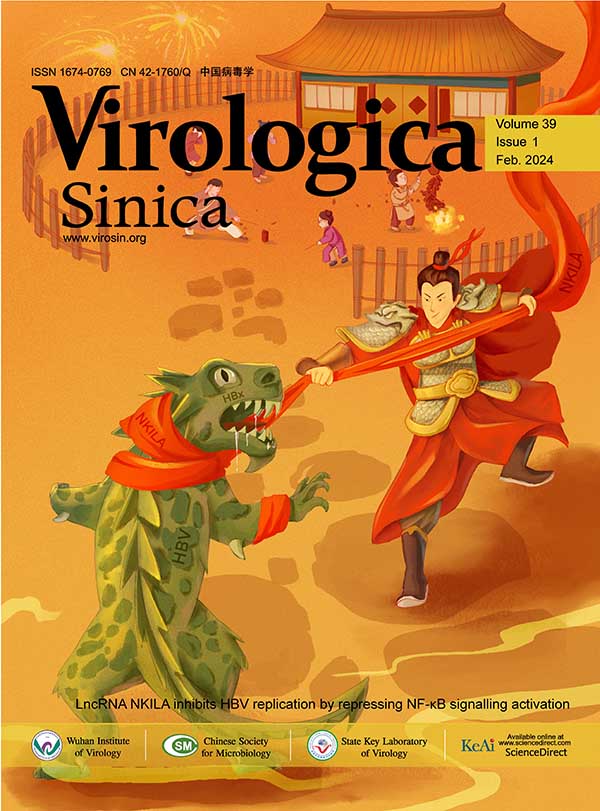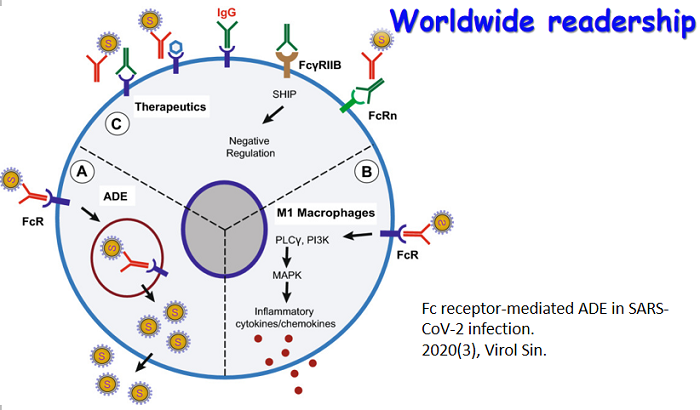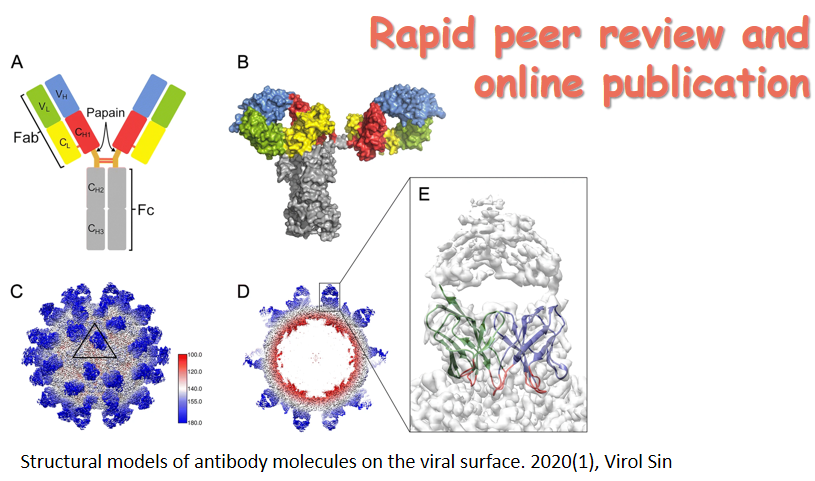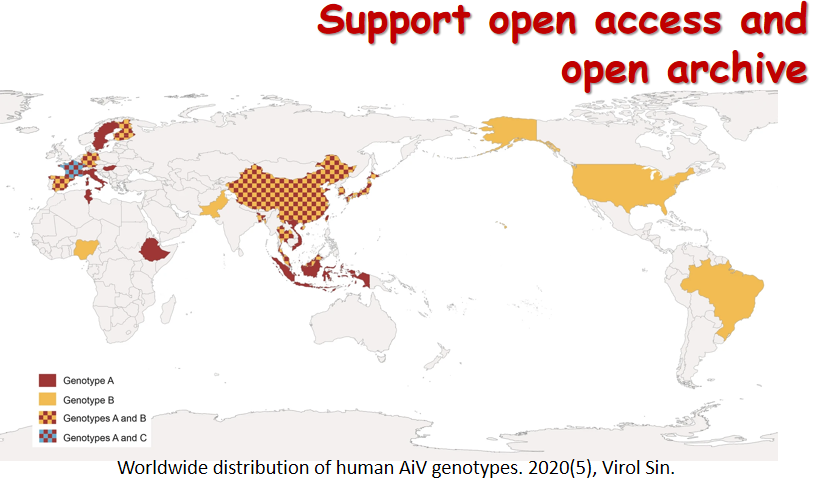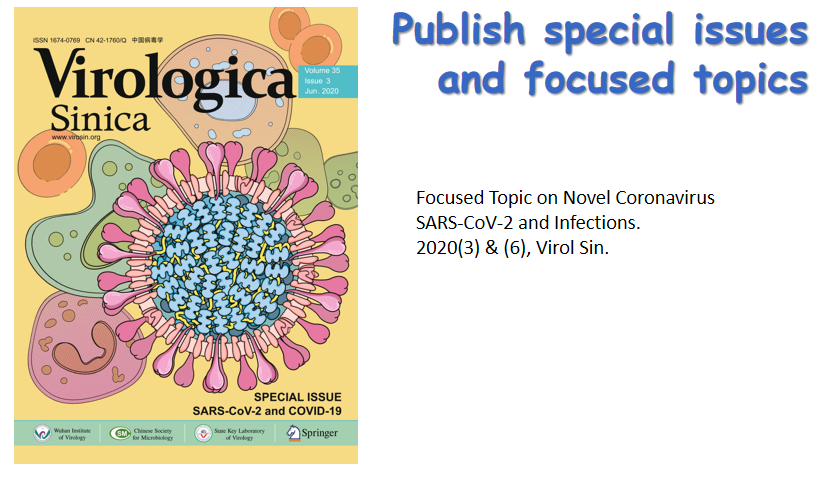|
To develop an attenuated recombinant adenoviral vaccine against Hepatitis C virus infection , we construct the recombinant adenoviral vector expressing non-structural protein 3(NS3) antigen of HCV(RAd-NS3). The HCV NS3 gene enconding for 329-935aa was amplified from the plasmid pRC/NS3 by PCR and cloned into the adenoviral shuttle plasmid pAdTrack-CMV. A two-step transformation protocol was employed for the construction of recombinant adenoviral plasmid pAdEasy-HCV NS3. The identified recombinant DNA was transfected into 293 cells to package adenovirus. From cell lysis , the presence of recombinant adenovirus was continued by PCR, and RT-PCR demonstrated the transcription of NS3 in HepG2 cells infected with RAd-NS3, and Western blot revealed that NS3 protein can express in infected HepG2 cells. These results indicated that tumor cells infected with recombinant adenovirus vector RAd-NS3 can express NS3 antigen ,which will be potentially used as a candidate vaccine for the prophylaxis and
To identify the pathogen isolated from lung tissue of a patient died from SARS by using electron microscope. Sample of lung tissue taken from autopsy of the SARS patient was inoculated onto Hep2 cultured cells. Any cultured cells exhibiting cytopathic effect were processed by routine techniques for ultrathin sections. Electron microscopic examination revealed the characteristic morphological features of reovirus. The virus particles showed in different mature stages, the matured particles with dense core and the incompletely assembled virus particles with lucent core. Both of them have capsid about 14nm in thickness with a size of virions about 60-80nm in diameter. Most of the virions were found in large clusters arranged in crystalline array and associated with the viral plasm and microtubular-like structure to form cytoplasmic inclusion bodies of different size and shape. In this study, we have provided further morphological evidence that reovirus may be associated with SARS. However, the correlation of the
Vaginal tract mucosae were the main place of Papillomaviruses replication and sexually transmission. More than 70% of women suffering from cervical intraepithelular neoplasia do not have HPV-specific antibodies in the genital secretion. Therefore, it is very important to develop vaccines, which mainly induce the mucosal immunity against Papillomavirus infection. An attenuated salmonella-based Papillomavirus vaccine was developed. pET-16 L1E7CTA2B plasmids were constructed by inserting the L1E7 DNA fragment upstream of CTA2B in pET-20b under the control of IPTG-inducible promoter T7. The pNir-16L1E7CTA2B contained the hybrid NirB promoter and were developed by digestion and reassemble of both the T7 promoter of pET-20b and the nirB of pTETnir15, so hybrid nirB-T7 promoter contained the FNR and the basic element (TATA box) form nirB and ribosome-binding site form T7 promoter, could drive the transcription and expression the target genes. The BALB/c mice were inoculated with the pNir-16L1E7- and pNir-16L1E7CTA2
To study the immunological speciality of M protein of SARS-CoV and analyze the feasibility and necessity of M protein as the component of the SARS vaccine. M protein of SARS-CoV was expressed in E.coli by pET-15b and pET-22b and purified by affinity resin as antigen. M gene was cloned into the eukaryotic secretory expression plasmid pSecTagB and named recombinant plasmid pSecM as DNA vaccine which will be used to immunize BALB/c mice to obtain the antiserum of M protein. The immune effect of the M-DNA vaccine was studied by the ELISA technique established with purified M protein. Both of the recombinant M proteins can be expressed in soluble form. When compared with the SARS-CoV ELISA kit produced by Huada Co.Ltd, the prokaryotic reconbinant M proteins could react specifically with the sera from immunized M-DNA mice and SARS correct diagnosis patients. The recombinant M protein could be used as an antigen to detect SARS, and the SARS-CoV M gene vaccine could induce specifically antibody. M protein could be
Based on a constructed prokaryotic expression plasmid which carries a ma-jor antigenic segment of E gene of JEV strain SA14-14-2 in our lab, we expressed the gene in methylotrophic yeast Pichia pastoris. The segment was choosn based on an- alysis provided by a computer software because of its higher antigenic index. The seg- ment was 1113bp, encoding 371 aa. The gene was subcloned into the vector pPICZα-A. The constructed plasmid was transformed into yeast X-33 by electrophoration. The recombinant transformants were selected by Zeocin. Induced by the addition of metha- nol every 24h, the product analyzed by SDS-PAGE was about 44kDa and 50kDa at a yield of 290 mg per litter of culture. The result of Western blotting indica- ted that the two bands both have specific antigenicity mainly owing to heterogeneous glycosylation. Coating with the supernatant, we can easily discriminate the positive serum from the negative, which should be useful for the production of diagnostic agents and genetically engineered vaccine vaccine of J EV.
To study the antiviral activity of Arbidol hydrochloride on Coxsackievirus Group B_3 (CVB_3), the antiviral effect of Arbidol hydrochloride were evaluated with virus inhibitory rates by MTT assay and 50% tissue culture infection dose (TCID_(50)) of the supernatant. The results showed that the viral inhibitory rates were up to 75.48%,45.68%,28.90% and 48.27% respectively in interrupting viral biosynthesis group, directly killing virus group, interfering in viral absorption and penetration groups(2h and 8h). In interrupting viral biosynthesis group,Arbidol hydrochloride could significantly inhibit cytopathic effect (CPE) of CVB_3-infected HEp-2 cells, increase survival rates of CVB_3-infected cells in dose dependent manner and decrease viral titers of the supernatant. It indicates that Arbidol hydrochloride has antiviral effect against Coxsackievirus group B3 (CVB_3).
In order to establish a convenient method to detect Porcine Circovirus(pcv2),the ORF2 gene of pcv2 was intergraded into the genome of methylotropic yeast Pichia pastoris to construct an engineering yeast.The ORF2 fragment was successfully secreted into the medium after induced with methanol.Gel thin layer scanning and Bradford total protein analysis results showed that the amount of the expressed product was about 47mg/ L,Compromising 58% of total culture supernatant protein in X-33/pPICZa-ORF2.Indirect ELISA showed the expressed product can be a good antigen and can differentiate the standard positive and negative serum of pcv2 effctively.
In order to determine the effect of deletion of gE, gI and TK on the characteristics of virion, we studied the property in cell culture, physicochemical characters and the morphogenesis in vero cells of Pseudorabies virus(PRV) gene-deleted vaccine strain SA215. The results indicated that PRV SA215 had the similar process of adsorption and penetration kinetics as its parental strain Fa; however, the course of replication was prolonged. Furthermore, the deletion of gE, gI and TK only has slight effect on physicochemical characters. The comparative analysis of SA215 and Fa on the morphogenesis in cultured cells suggested that the process of budding from nucleus membrane and forming of secondary envelope were delayed or arrested. The results provide guidance for manufacture of PRV gene-deleted vaccine SA215.
E0 protein of Classical swine fever virus(CSFV) is of discriminatory feature in serum diagnostic test for developing CSFV Marker vaccine. It is also expected to be useful for monitoring CSFV prevalence,evaluating immunization efficacy and establishing immunization procedure. To obtain a large amount of E0 protein in vitro ,the Hog cholera lapinised virus(HCLV) E0 gene was cloned into prokaryotic expression plasmids, pGEX4T、pET30 and pMAL-p2X respectively.After the recombinant expression plasmids were transformed into BL21、BL21(DE3)、TB1、BL21-codonplus(DE3)-RP respectively, the expression product were analyzed by investigating the IPTG induction concentration ,incubation temperature and time. The results revealed that the E0 protein could be expressed in the systems, namely pGEX4T/BL21-codonplus(DE3)-RP and pMAL-p2X/ BL21-codonplus(DE3)-RP as inclusion bodies accounted for 15% and 30% of whole bacterial protein. Two methods , B-per reagent and triton-urine, were applied to wash the inclusion body and both ˎ̥,Verdana,Arial; mso-font-kerning: 1.0pt; mso-bidi-font-family: 'Times New Roman'; mso-fareast-font-family: 宋体; mso-ansi-language: EN-US; mso-fareast-language: ZH-CN; mso-bidi-language: AR-SA">access to the relatively good effect . After the protein refolding of denaturant inclusion body following dialysis , we got the pure recombinant GST2E0 protein by GST affinity columns. Using the purified protein as coating antigen , an indirect EL ISA is developed for detecting the anti2E antibody in t he CSFV serum by exploring the concent ration of coating antigen and dilution degree of serum , which will provide a good f undament for development of CSFV antibody surveillance kit .
A binary plasmid was constructed by triparental mating, which contained the vp1 gene of foot-and-mouth disease virus strain Akesu/58 serotype O. The Nicotiana Benthamiana (NC) leaves were transformed by Agrobacterium tumefaciens-mediated method with the binary expression plasmid. After selected by kanamycin, forty-nine resistant lines were obtained. Forty lines were positive through PCR with total DNA and twenty-one lines were positive through RT-PCR with total RNA from fresh leaves tissue. The leave extracts of seven positive lines analyzed with ELISA and western-blot were respectively emulsified in Freund′s adjuvant and the Balb/C mice were immunized intraperitoneally at days 0,15,30 and 45. After the last inoculation, the sera antibody were analyzed at 9 days and the mice were experimentally challenged intraperitoneally with 10~4 suckling mouse 50% lethal doses (SM_(50)LD) of FMDV at 12 days. Protection was determined by the absence of viremia at 24h post-inoculation. ˎ̥,Verdana,Arial; mso-font-kerning: 1.0pt; mso-bidi-font-family: 'Times New Roman'; mso-fareast-font-family: 宋体; mso-ansi-language: EN-US; mso-fareast-language: ZH-CN; mso-bidi-language: AR-SA">Viremia was tested by intradermal in ˎ̥,Verdana,Arial; mso-font-kerning: 1.0pt; mso-bidi-font-family: 'Times New Roman'; mso-fareast-font-family: 宋体; mso-ansi-language: EN-US; mso-fareast-language: ZH-CN; mso-bidi-language: AR-SA">intradermal inoculation of perip heral blood into suckling mice. These results showed that the const ructed binary expression plasmid was functionary ; vp1 gene was transformed into NC plants and expresed affirmatively ; the structure protein VP1 expressed in two transgenic plants lines may possibly be used as a source of antigen , the inoculated Balb/C mice developed a specific antibody response ; the protection against FMDV challenge in two groups was 100 % and 63 % respectively.
A transient three-plasmid expression system for the production of pseudotyping virions were used to construct the pseudotype of murine leukemia virus(MuLV) with avian influenza virus hemagglutinin(HA) glycoproteins. Co-transfected pcDNA-HA, pHIT60(include MuLV structural genes, namely Gag and Pol) and pHIT111(retroviral genome, containing Lac Z as a reporter) into 293T cells. The retroviral supernatants were harvested 48 hours post-transfection, filtered through a 0.45μM filter. The supernatant were used to analysis the characteristic of the pseudotyping virions by Western blotting and infection test. Western blotting revealed the HA glycoproteins can be expressed on the virions, indicated the HA glycoproteins were incorporated onto the retroviral virions. Infection test were performed on 293T、NIH3T3 and COS-7, all the three kinds of cells infected were Lac Z positive, indicating viral entry, and revealed the pseudotype virions of MuLV-HA were infectious. The pseudotype system of MuLV particles with AIV ˎ̥,Verdana,Arial; mso-font-kerning: 1.0pt; mso-bidi-font-family: 'Times New Roman'; mso-fareast-font-family: 宋体; mso-ansi-language: EN-US; mso-fareast-language: ZH-CN; mso-bidi-language: AR-SA">Hemagglutinin proteins were set up and it can be used to study the ent ry of avian influenza virus isolated f rom goose in China.ˎ̥,Verdana,Arial; mso-font-kerning: 1.0pt; mso-bidi-font-family: 'Times New Roman'; mso-fareast-font-family: 宋体; mso-ansi-language: EN-US; mso-fareast-language: ZH-CN; mso-bidi-language: AR-SA">Hemagglutinin proteins were set up and it can be used to study the ent ry of avian influenza virus isolated f rom goose in China.
According to mutations occurred in the passages during the Equine infectious anemia virus (EIAV) vaccine attenuation, a full length chimeric gene clone, pLGFD9-12, was constructed successfully at a backbone of clone pLGFD3-8 by substitution with LTR U3 region of a virulent EIAV strain. The pLGFD9-12 was used to transfect fetal donkey dermal (FDD) cells and passaged in donkey leukocyte (DL) culture. The cell cultures were monitored by RT-PCR, reverse transcriptase activity assay and real-time RT-PCR. The results of RT activity and RT-PCR were positive in the supernatant of cell cultures and viruses particles were also clearly observed under electron microscope. The replication of pLGFD9-12 chimeric viruses and its parental virus pLGFD3-8 has no obvious differences. The level of replication of the pLGFD9-12 chimeric clone cultured in DL cells was higher than that in FDD cells. The characteristics on virulence and replication ability of pLGFD9-12 will be evaluated in vivo.
To construct a new type of vaccine for dog Rabies prevention, Canine adenovirus type-2 was developed for Rabies virus glycoprotein expression. A 1044bp fragment of the E3 region of canine adenovirus type-2 in plasmid pVAX-E3(7.86kb) was deleted by Dra Ⅲ/SspⅠdouble digestion, and an expression cassette of 2424bp in length, composed of the cytomegalovirus immediately early promoter, Rabies virus strain SRV_9 glycoprotein cDNA and SV40 polyadenylation signal, was cloned into the deleted site. The NruⅠ-SalⅠfragment of pPolyⅡ-CAV-2 excluding the E3 region and the NruⅠ-SalⅠfragment of pVAX-E3 containing the expression cassette of the Rabies virus glycoprotein were recombined into pPolyⅡ-CAV2-CGS. The recombinant CAV-2 genome was released by AscⅠ/ClaⅠdigestion and was transfected into MDCK cells by Lipofectamine~(TM) 2000. Canine adenovirus typical CPE and the recombinant virus, CAV-2-CGS, were observed 8 d after transfection. Rabies virus glycoprotein expression was confirmed by Western blotting analysis. ˎ̥,Verdana,Arial; mso-font-kerning: 1.0pt; mso-bidi-font-family: 'Times New Roman'; mso-fareast-font-family: 宋体; mso-ansi-language: EN-US; mso-fareast-language: ZH-CN; mso-bidi-language: AR-SA">Preliminary immunization trial in dogs showed that the recombinant virus could stimulate specific immune response to both vector virus and Rabies virus .
Simian vacuolating virus 40(SV40)belongs to polyoma virus and is a DNA tumor virus.The natural hosts for SV40 are species of Asian macaque monkeys, especially the rhesus (Maccaca mulatta). SV40 can cause widespread infections leading to acutely pathological changes and long-term virus schleping in healthy monkeys. SV40 was shown to be tumorigenic in rodents and was able to transform many types of cells in culture. This work represented the first description of inactivated SV40 by beta-propiolactone and evaluated its immunogenic properties in mice. This work was a primary attempt to tackle SV40 infection and spread has made it ready to further investigate the immunological characteristics of the inactivated virus in monkeys and provided a foundation for vaccine development against SV40.
The tissues samples of 828 chickens suspected to be infected by immunodepressive viruses from 42 shicken flocks were collected in Shandong, Henan,Hebei,Beijing,Jiangsu,Guangdong,Guangxi,Sichuan,Jilin,Liaoning and Taiwan,and the DNA was extracted for hybridization in Dot-blot with probes for Marek′s disease virus(MDV), Reticuloendotheliosis virus(REV) and Chicken anemia virus(CAV). The results indicated that the checkout ratios of the three viruses are 83.94%(MDV),61.0%(CAV)and 57.25%(REV);the ratios of triple infection,dual infection,single infection and negative are 44.69%,31.16%,15.34% and 8.82%; respectively;29 of 42 chicken flocks occur triple infection(69.05%),5 ones occur dual infection of MDV and CAV(11.90%)3 ones occur dual infection of MDV and REV(7.14%),and two ones not occur MDV、CAV and REV; all the 11 provinces exist MDV,CAV and REV. The results indicated that existing in wide range and co-infection of MDV,CAV and REV in chickens are the important causations for descent of poultry production performance , high incidence opport unistically pat hogenicdiseases and int umescentia provent ricularis in China.
Using suppression subtractive hybridization (SSH) technique, a subtractive cDNA library was constructed from Japanese flounder (Paralichthys olivaceus) embryonic cells (FEC) induced by UV-inactivated dsRNA virus GCHV (Grass carp hemorrhage virus). A housekeeping gene, α-tublin, was used to estimate the efficiency of subtractive cDNA. In this library, α-tublin was subtracted at about 2~(10) folds, indicating that some differentially expressed genes were also enriched at about the same folds. The length of the subtractive cDNA fragments cloned into pGEM-T vector ranged from 250bp to 2000bp.The results showed that the subtractive cDNA library is successful, which will be very useful for the understanding of antiviral immune response to dsRNA virus and essential for rapid isolation of differentially expressed genes induced by dsRNA virus.
Autographa californica multicapsid nucleopolyhedrovirus(AcMNPV) blocked the Tn-Hi5 cell apoptosis stimulated by Helicoverpa armigera nucleopolyhedrovirus (HaSNPV). Futhermore AcMNPV could rescued HaSNPV replication in Tn-Hi5 cell and produced infective virus. This means that HaSNPV extend the host rang with AcMNPV help. The transient expression assay indicated that Ac-p35 could significantly inhibit the Tn-Hi5 apoptosis induced by HaSNPV.A recombinant HaSNPV which overexpression of p35: vHap35, was constructed to futher analyse P35 function. vHap35 was used to infect Tn-Hi5 as we expected the Tn-hi5 cell did not undergo apoptosis. Anyhow, no infective virus BV was detected. Under the electronic microscope viral particles were observed, which probably are the ODVs. The results demonstrat that p35 is funtional as both apoptosis inhibitor and host range factor.
Repeated passage of several fungus-transmitted plant viruses can lead to sequence deletion in their hosts. In this paper, Northern blotting analysis revealed that a low molecular weight component of Wheat yellow mosaic virus(WYMV) RNA1 was detected after the twelfth passage of mechanical inoculation in wheat plants associated with exacerbate symptoms displayed and exist stably in the inoculated plants to the 26th passage in the experiment. However these low molecular weight RNAs could not be detected in the particles purified from the same infected samples, suggesting that they could not encapsidated in infected wheat. Sequence analysis showed that a contiguous segment of 2380 nucleotides(nt68 to nt2448) was internally deleted from the WYMV RNA1 and flanked by direct repeats of six nucleotides CGTCTC, which supports the “copy choice” model as the possible mechanism of the generation of this low molecular weight component of WYMV RNA1.
Golden hamster is one of the favored experimental models for studying mechanisms of transmissible spongiform encephalopathies (TSEs). We used the real-time fluorescent RT-PCR technique, constructing the standard plasmid and curve to quantify the PrP gene expression. Total RNA was isolated from four different regions of the brain and six peripheral organs to quantify the gene expression after the reverse transcript. The results showed that high mRNA levels were present in all four regions of the brain examined. In peripheral organs examined, inguinal lymph node showed high level of expression similar to that in brain, spleen, heart, liver and lung showed moderate levels of the expression and kidney showed the lowest expression. Our results provided the basic data of the function of the PrP~c and the effection of different organs in prion diseases.
With the reverse transcription chain reaction (RT-PCR), the gene of Canine′s interfe ron-alpha (CaIFN-α) was amplified and cloned , from the total RNA in the lymphocytes stimulated with concanavalin A from the peripheral blood of dog. The amplified fragment was inserted into the prokaryotic expressing vector pBV220 and then sequenced. Sequencing result showed that the homology was 100% between the gene we cloned and the one published in GenBank. SDS-PAGE assay showed that the target protein, with the molecular weight of 19kDa, could be expressed in a high level and up to 27.6% of the total protein in E.coli cell, in the form of inclusion bodies. The target protein was added to MDCK cells,which were subsequently infected by the 100 TCID_(50) VSV. The result showed good cytokine activity. The recombinant CaIFN-α activity was up to 5.11×10~6U/㎎.
Ad5-knob gene from AdEasy plasmind DNA was amplified by polymerase chain reaction (PCR) and cloned into an E. coli expression vector pQE30 digested with BamH I and Hind III. After induction with IPTG, the transformed E. coli strain M15 expressed Ad5-knob gene efficiently. Moreover, the recombinant Ad5-knob protein mainly existed as a soluble protein. After one step purification with Ni~(2+)-NTA affinity chromatography, the protein was purified to nearly homogeneity. N-terminal amino acid sequencing indicated N-terminus of purified Ad5-knob. When FITC-labeled Ad5-knob transfers Hela cells, it can specially bind to the receptor to the surface of Hela cells and enter the cytosol. It suggests that the recombinant Ad5-knob protein identified and purified is to be suitable for nonviral gene carriers as a target protein in future studies.
Based on the reported Big liver and spleen disease virus (BLSV) gene sequence, a pair of primers was designed and a 375bp product was amplified from the total RNA extracted from homogenates of BLSV-infected livers. Twenty liver samples were randomly collected from two commercial broiler breeder flocks in Nanjing.One of ten liver samples was positive reaction in RT-PCR in one flock but not in another. The RT-PCR detection for cDNA from BLSV was specific with the sensitivity of 4.16×10~(-3)μg/μL. Phylogentic tree analysis suggested that the 338bp sequence of the isolated strain (BLSV-NJ2002) shared 97.3% and 83.6% nt hemologue indentities with that of Australia strain and avian HEV respectively.
Using two pairs of primer based on conserved sequences of the NP gene of influenza A virus, a RT-nested PCR assay was developed to detect Swine influenza virus in clinical samples. No cross reactions with three other swine pathogens of respiratory disease such as Porcine respiratory and reproductive syndrome virus, Porcine circovirus type 2 and Mycoplasma suipneumoniae. With agarose electrophoresis detection, the RT-nested PCR was 100 times more sensitive compared to that of non-nested RT-PCR. 35 clinical samples including 4 blood samples and 31 lung tissues from Southern China were tested by RT-nested PCR, and 28 (80%) out of 35 sample were positive. By propagated in 9-to 10-day-old SPF embryonated chicken eggs, 23 strains of Swine influenza virus were isolated from 28 positive samples. The result of RT-nested PCR was 82% in agreement with that of virus isolation, and the RT-nested PCR were more sensitive than the virus isolation. No Swine influenza virus was isolated from the all RT-nested PCR negative samples. On the basis of characterization of HA gene sequences , 5 out of 23 strains had H3 and H9 subtypes. It suggested that the RT2nested PCR assay was rapid ,specific and sensitive , and it was is advantageous to detect influenza virus in latent infections.
In this study, the RNA of PRRSV HN1 strain was isolated and the cDNA fragments were amplified by RT-PCR. These fragments were then inserted to T-vector and constructed the cDNA library. The genome of PRRSV HN1 strain was sequenced and submitted to the GenBank obtained the ID: AY457635. The homology between this HN1 and other strains was analyzed. HN1 strain has the lowest homology with the Netherlands isolate LV which is 56.0%, and has the highest homology with the USA isolate MLV and VR2332 which is 99.1% and 99.0% respectively. The HN1 strain and MLV and VR2332 are on the same evolution branch, it proved that the HN1 strain is North America strain. In China, the HN1 strain has the highest homology with Beijing isolate BJ-4 (99.0%) and the lowest homology with another Beijing isolate HB2 (89.0%).
In order to improve the diagnostic efficiency of the hepatitis C in China, the DNA fragments of core, C33c,NS4 in Hepatitis C virus(HCV) were connected and subcloned to pET24a(+). The pET24a-CCN was highly expressed with the inducement IPTG in the E.coli BL21(DE3). In 1L bacterial culture medium,30mg purified recombinant proteins were available using His Binding Resin under denatured condition. Used as diagnostic antigen to detect the human hepatitis C by ELISA, The results showed that the 100% positive coincidence rate (66/66) and 94.5% negative coincidence rate (86/91) were obtained. To detect 46 positive HAV sera and 46 positive HBs sera, all the results were negative. At the same time, the freeze-dried recombinant antigen detects 66 HCV positive sera, all the results were positive. Therefore, the recombinant antigen was sensitivity, specialty and stability to detect hepatitis C. It was an ideal reagent to detect hepatitis C.







